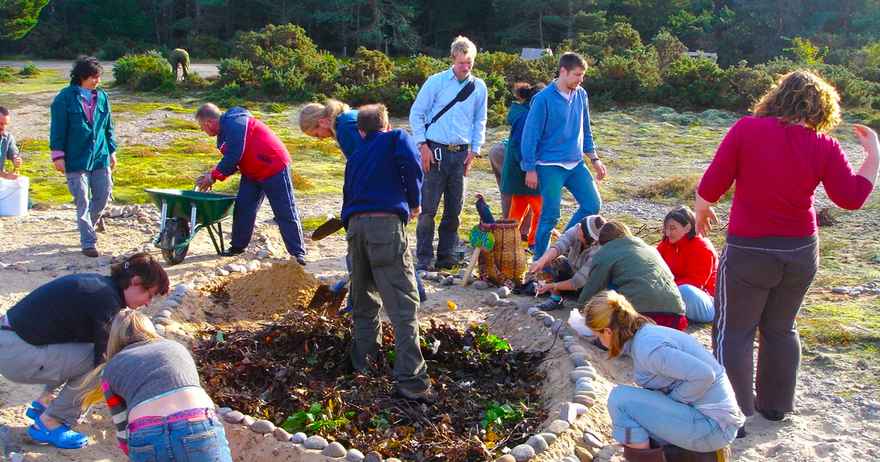The School Garden

Sewing the Sustainable Development Goals into the grounds of Education. Exploring the benefits that can be unleashed when a school garden combines with the classroom, a non negotiable way to imbibe the fundamental underpinning of all the SDGs into education.
The UN’s Sustainable Development Goals aim to end poverty, food insecurity, inequality, prejudice, exclusion and environmental degradation while fostering among all humans the belief in global citizenship. That sounds like quite a tall order, and surely the essential question at present is: how can we achieve these ambitious aims by integrating them into our educational provision at all levels and to reach all children, to aim for universal application of the goals while respecting the need for distinct cultural identities?
Perhaps this is a good opportunity, therefore, to review our educational paradigms altogether. Rather than merely tinkering, we can grasp the potential for radical interventions in a system that poorly serves the requirements of the present age and disadvantages too many children in the process. As creativity consultant and educationist Sir Kenneth Robinson has pointed out so eloquently:
“The current system of education was designed and conceived in a different age. It was conceived in the intellectual culture of the Enlightenment and in the economic circumstances of the Industrial Revolution…there is also built into it a whole series of assumptions about social structure and capacity.”
That is to say, our educational paradigms are underpinned by an outmoded intellectual model of the mind that prioritises academic achievements and is driven by economic imperatives that are no longer current. Class, race and gender prejudices are implicit to the model. As Robinson also points out, schools are organised along the lines of a factory churning out children in batches along a conveyor belt of standardised testing. This is the Western model that has been exported across the globe.
A need for change in the educational system
If we are radically rethinking our educational paradigms to equip our young people with the skills and knowledge they will need to meet the contingencies of a dynamically different future, to embrace global citizenship and render the Sustainable Development Goals a self-evident facet of everyday life, then we will also need to reject the linear mindset that has created our contemporary crisis. We can all agree with Einstein when he said: ‘We can’t solve problems by using the same kind of thinking we used when we created them’.
As Daniel Christian Wahl points out in “Ecoliteracy: Learning from Living Systems”:
“We need to reintegrate our economic activities, the way we meet our needs and how we produce and share value, with the basic rules of ecology. Our design and technology need to be aligned with the way that life and living systems are structured and how they maintain their vital functions in support of individuals and the whole system.”
To meet our present contingencies, we need a whole-system approach modelled on paradigms gleaned from nature itself. Global citizenship is equally planetary citizenship, we need to understand the place we occupy as a species within the ‘community of life’ that includes all species in all ecosystems existing within that narrow, somewhat fragile 25km strip around the planet we call the biosphere — the crucial space where the conditions that sustain all life on this planet exist.
A holistic approach to transforming educational paradigms
If we are to redesign our educational paradigms around whole-systems thinking, around citizenship of that life-enhancing space, what better place to start than with school gardens where children grow food, learn and play, collaborate with nature and each other all in a single microcosm. Schools designed around permaculture, or agro-ecology, edible ecosystems would be able to gear the entire curriculum to interdisciplinarity, multiple intelligences, co-creativity and collaboration, teaching sciences and humanities to all ages while committing to the health and well-being of the students, and, therefore, their communities.
Paradigm shifts in the sciences
There are new paradigm shifts taking place in the sciences endorsing concepts many indigenous peoples have always known. We are citizens of this biosphere in which all life is interconnected and interrelated. As the Canadian geneticist David Suzuki points out, we share 99% of our DNA with our closest cousins the chimpanzees, but we also share 50% of our genetic material with bananas and 40% with cabbages. Our human DNA is a mere 10% of the genetic material in our own bodies, 90% being constituted by the microbes that regulate our digestion, our immune system, our metabolism and even our brain chemistry. We inhale oxygen exhaled by trees. Evidently, we are not separate from nature, nor from each other, and we must reject the current ideology of separation to fully understand ourselves as a species and our global and planetary citizenship. Through a new educational paradigm built around edible ecosystems, we can introduce children to this awareness from the very start of their schooling. Children would learn about climate, water management, integral pest management, and also have a healthy diet of organic vegetables, fruit, nuts and animal proteins to add to the cereals (and sugars) that form too high a proportion of our daily intake of calories at present.
A carefully designed agro-ecology/permaculture school garden goes beyond combating hunger and food insecurity. The physical laws of the universe are present in nature and, therefore, in a school garden; the laws of thermodynamics, Earth system science, biology, ecology, and even mathematics are evident in a school garden; biomimicry becomes the basis for engineering.
Watch this stunning video by Christóbal Vila illustrating how the Fibonacci numbers are intrinsic to the patterns in nature, merging maths, nature, technology and music into an aesthetic experience.
Paradigm shifts in the sciences
There are new paradigm shifts taking place in the sciences endorsing concepts many indigenous peoples have always known. We are citizens of this biosphere in which all life is interconnected and interrelated. As the Canadian geneticist David Suzuki points out, we share 99% of our DNA with our closest cousins the chimpanzees, but we also share 50% of our genetic material with bananas and 40% with cabbages. Our human DNA is a mere 10% of the genetic material in our own bodies, 90% being constituted by the microbes that regulate our digestion, our immune system, our metabolism and even our brain chemistry. We inhale oxygen exhaled by trees. Evidently, we are not separate from nature, nor from each other, and we must reject the current ideology of separation to fully understand ourselves as a species and our global and planetary citizenship. Through a new educational paradigm built around edible ecosystems, we can introduce children to this awareness from the very start of their schooling. Children would learn about climate, water management, integral pest management, and also have a healthy diet of organic vegetables, fruit, nuts and animal proteins to add to the cereals (and sugars) that form too high a proportion of our daily intake of calories at present.
A carefully designed agro-ecology/permaculture school garden goes beyond combating hunger and food insecurity. The physical laws of the universe are present in nature and, therefore, in a school garden; the laws of thermodynamics, Earth system science, biology, ecology, and even mathematics are evident in a school garden; biomimicry becomes the basis for engineering.
Watch this stunning video by Christóbal Vila illustrating how the Fibonacci numbers are intrinsic to the patterns in nature, merging maths, nature, technology and music into an aesthetic experience.
Hyperbolic geometry is also evident in the patterns of nature, even in the patterns of lettuce leaves, and can be illustrated in a school garden. It can inspire art that is equally community activism as shown by the mathematical crocheted corals created by the Wertheimer sisters to exhibit the threats the Great Barrier Reef in the Hyperbolic Crochet Coral Reef project in 1997. It also shows how complex mathematical models are embodied in the ecosystems of our planet.
An alternative school of thought — a garden one…
The new educational paradigm centred on school gardens will offer children the space to be creative, develop divergent thinking, and teamwork through collaboration and trust. When a school garden combines with the classroom, project-based participatory learning becomes the norm from an early age and what better way to imbibe the fundamental underpinning of all the SDGs, that equality, inclusivity, social justice and a fair distribution of resources without bias based on species, race, age, gender, sexuality and status is the only recipe for a healthy, prosperous and peaceful community, locally and globally.
Arts and humanities equally find their expression through contact with nature: our most profound narrative fictions, music, dance, poetry, painting, sculpture, fashion, jewellery and decoration have been inspired for millennia by the relationship between humans and nature.
“All the world’s problems can be solved in a garden” Geoff Lawton, permaculture designer.
We must learn to live together as part of a community of life that respects the needs of all living things. We must be aware of our interconnectedness within that community of life. It is those connections that render our communities and ecosystems resilient against shocks. As biologist David George. Haskell has pointed out:
“There is no such thing as an individual within biology,…instead, the fundamental unit of life is interconnection and relationship … Without interconnection life ends.”
Moreover, there are major health benefits to be gained from gardening. There is growing evidence from neuroscience that our human brains are hardwired to recognise the complexity in nature and not the blandness of modern cityscapes. In Places of the Heart Colin Ellard argues:
“Human beings have evolved to operate in environments with optimal levels of complexity related to our biology. We seek out such settings with our eyes, our bodies, our hands and our feet”.
Equally, a great number of scientific studies increasingly show that we need the phytochemicals and microbes present in plant life and soil, not only for our physical well-being but for brain chemistry too. And as agriculture itself is potentially the origin of inequality and aggression, as hypothesized by many academic researchers, such as Prof Jared Diamond, it makes perfect sense to combine new educational paradigms with new agricultural paradigms, advancing the small-scale agro-ecology advocated by the FAO.
Contact with the community of life in the microcosm of a school garden, an edible ecosystem, is evidently beneficial for our mind, body and spirit, attuning us to citizenship of the biosphere, offering an education that merges academic and vocational skills, interdisciplinary sciences, humanities and arts, fosters collaboration, co-creativity and co-intelligence to equip us with new understandings and paradigms for problem-solving, the means to generate equitable solutions to local and global problems. Surely, this is the aim of the SDGs and a true global citizenship.
References:
- https://www.thersa.org/globalassets/pdfs/videos/transcripts/rsa-lecture-ken-robinson-transcript.pdf
- https://www.youtube.com/watch?v=S2b7SpLpN5A (David Suzuki And Elder’s Vision for a Sustainable Future.
- https://www.youtube.com/watch?v=i-icXZ2tMRM Rob Knight How Microbes Make Us Who We Are
- http://crochetcoralreef.org/contributors/margaret_wertheim.php
- http://e360.yale.edu/features/how-listening-to-trees-can-help-reveal-natures-connections
- https://aeon.co/essays/why-boring-streets-make-pedestrians-stressed-and-unhappy
- Guns, Germs and Steel: A Short History of Everybody for the Last 13,000 Years. Prof Diamond uses his studies of hunter-gatherer communities on Polynesian Islands and compares them with agricultural societies on neighbouring islands.




0 comments
Leave a comment